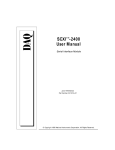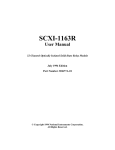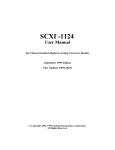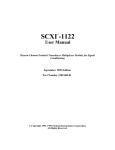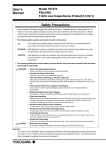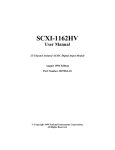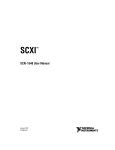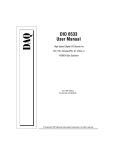Download SCXI-1104/C User Manual
Transcript
SCXI ™ SCXI-1104/C User Manual 32-Channel Medium-Voltage Input Module SCXI-1104/C User Manual February 2000 Edition Part Number 322147B-01 Worldwide Technical Support and Product Information www.ni.com National Instruments Corporate Headquarters 11500 North Mopac Expressway Austin, Texas 78759-3504 USA Tel: 512 794 0100 Worldwide Offices Australia 03 9879 5166, Austria 0662 45 79 90 0, Belgium 02 757 00 20, Brazil 011 284 5011, Canada (Calgary) 403 274 9391, Canada (Ontario) 905 785 0085, Canada (Québec) 514 694 8521, China 0755 3904939, Denmark 45 76 26 00, Finland 09 725 725 11, France 01 48 14 24 24, Germany 089 741 31 30, Greece 30 1 42 96 427, Hong Kong 2645 3186, India 91805275406, Israel 03 6120092, Italy 02 413091, Japan 03 5472 2970, Korea 02 596 7456, Mexico (D.F.) 5 280 7625, Mexico (Monterrey) 8 357 7695, Netherlands 0348 433466, New Zealand 09 914 0488, Norway 32 27 73 00, Poland 0 22 528 94 06, Portugal 351 1 726 9011, Singapore 2265886, Spain 91 640 0085, Sweden 08 587 895 00, Switzerland 056 200 51 51, Taiwan 02 2528 7227, United Kingdom 01635 523545 For further support information, see the Technical Support Resources appendix. To comment on the documentation, send e-mail to [email protected] © Copyright 1998, 2000 National Instruments Corporation. All rights reserved. Important Information Warranty The SCXI-1104 and SCXI-1104C modules are warranted against defects in materials and workmanship for a period of one year from the date of shipment, as evidenced by receipts or other documentation. National Instruments will, at its option, repair or replace equipment that proves to be defective during the warranty period. This warranty includes parts and labor. The media on which you receive National Instruments software are warranted not to fail to execute programming instructions, due to defects in materials and workmanship, for a period of 90 days from date of shipment, as evidenced by receipts or other documentation. National Instruments will, at its option, repair or replace software media that do not execute programming instructions if National Instruments receives notice of such defects during the warranty period. National Instruments does not warrant that the operation of the software shall be uninterrupted or error free. A Return Material Authorization (RMA) number must be obtained from the factory and clearly marked on the outside of the package before any equipment will be accepted for warranty work. National Instruments will pay the shipping costs of returning to the owner parts which are covered by warranty. National Instruments believes that the information in this document is accurate. The document has been carefully reviewed for technical accuracy. In the event that technical or typographical errors exist, National Instruments reserves the right to make changes to subsequent editions of this document without prior notice to holders of this edition. The reader should consult National Instruments if errors are suspected. In no event shall National Instruments be liable for any damages arising out of or related to this document or the information contained in it. EXCEPT AS SPECIFIED HEREIN, NATIONAL INSTRUMENTS MAKES NO WARRANTIES, EXPRESS OR IMPLIED, AND SPECIFICALLY DISCLAIMS ANY WARRANTY OF MERCHANTABILITY OR FITNESS FOR A PARTICULAR PURPOSE. CUSTOMER’S RIGHT TO RECOVER DAMAGES CAUSED BY FAULT OR NEGLIGENCE ON THE PART OF NATIONAL INSTRUMENTS SHALL BE LIMITED TO THE AMOUNT THERETOFORE PAID BY THE CUSTOMER. NATIONAL INSTRUMENTS WILL NOT BE LIABLE FOR DAMAGES RESULTING FROM LOSS OF DATA, PROFITS, USE OF PRODUCTS, OR INCIDENTAL OR CONSEQUENTIAL DAMAGES, EVEN IF ADVISED OF THE POSSIBILITY THEREOF. This limitation of the liability of National Instruments will apply regardless of the form of action, whether in contract or tort, including negligence. Any action against National Instruments must be brought within one year after the cause of action accrues. National Instruments shall not be liable for any delay in performance due to causes beyond its reasonable control. The warranty provided herein does not cover damages, defects, malfunctions, or service failures caused by owner’s failure to follow the National Instruments installation, operation, or maintenance instructions; owner’s modification of the product; owner’s abuse, misuse, or negligent acts; and power failure or surges, fire, flood, accident, actions of third parties, or other events outside reasonable control. Copyright Under the copyright laws, this publication may not be reproduced or transmitted in any form, electronic or mechanical, including photocopying, recording, storing in an information retrieval system, or translating, in whole or in part, without the prior written consent of National Instruments Corporation. Trademarks BridgeVIEW™, ComponentWorks™, CVI™, LabVIEW™, Measure™, National Instruments™, ni.com™, NI-DAQ™, RTSI™, SCXI™, and VirtualBench™ are trademarks of National Instruments Corporation. Product and company names mentioned herein are trademarks or trade names of their respective companies. WARNING REGARDING USE OF NATIONAL INSTRUMENTS PRODUCTS (1) NATIONAL INSTRUMENTS PRODUCTS ARE NOT DESIGNED WITH COMPONENTS AND TESTING FOR A LEVEL OF RELIABILITY SUITABLE FOR USE IN OR IN CONNECTION WITH SURGICAL IMPLANTS OR AS CRITICAL COMPONENTS IN ANY LIFE SUPPORT SYSTEMS WHOSE FAILURE TO PERFORM CAN REASONABLY BE EXPECTED TO CAUSE SIGNIFICANT INJURY TO A HUMAN. (2) IN ANY APPLICATION, INCLUDING THE ABOVE, RELIABILITY OF OPERATION OF THE SOFTWARE PRODUCTS CAN BE IMPAIRED BY ADVERSE FACTORS, INCLUDING BUT NOT LIMITED TO FLUCTUATIONS IN ELECTRICAL POWER SUPPLY, COMPUTER HARDWARE MALFUNCTIONS, COMPUTER OPERATING SYSTEM SOFTWARE FITNESS, FITNESS OF COMPILERS AND DEVELOPMENT SOFTWARE USED TO DEVELOP AN APPLICATION, INSTALLATION ERRORS, SOFTWARE AND HARDWARE COMPATIBILITY PROBLEMS, MALFUNCTIONS OR FAILURES OF ELECTRONIC MONITORING OR CONTROL DEVICES, TRANSIENT FAILURES OF ELECTRONIC SYSTEMS (HARDWARE AND/OR SOFTWARE), UNANTICIPATED USES OR MISUSES, OR ERRORS ON THE PART OF THE USER OR APPLICATIONS DESIGNER (ADVERSE FACTORS SUCH AS THESE ARE HEREAFTER COLLECTIVELY TERMED “SYSTEM FAILURES”). ANY APPLICATION WHERE A SYSTEM FAILURE WOULD CREATE A RISK OF HARM TO PROPERTY OR PERSONS (INCLUDING THE RISK OF BODILY INJURY AND DEATH) SHOULD NOT BE RELIANT SOLELY UPON ONE FORM OF ELECTRONIC SYSTEM DUE TO THE RISK OF SYSTEM FAILURE. TO AVOID DAMAGE, INJURY, OR DEATH, THE USER OR APPLICATION DESIGNER MUST TAKE REASONABLY PRUDENT STEPS TO PROTECT AGAINST SYSTEM FAILURES, INCLUDING BUT NOT LIMITED TO BACK-UP OR SHUT DOWN MECHANISMS. BECAUSE EACH END-USER SYSTEM IS CUSTOMIZED AND DIFFERS FROM NATIONAL INSTRUMENTS' TESTING PLATFORMS AND BECAUSE A USER OR APPLICATION DESIGNER MAY USE NATIONAL INSTRUMENTS PRODUCTS IN COMBINATION WITH OTHER PRODUCTS IN A MANNER NOT EVALUATED OR CONTEMPLATED BY NATIONAL INSTRUMENTS, THE USER OR APPLICATION DESIGNER IS ULTIMATELY RESPONSIBLE FOR VERIFYING AND VALIDATING THE SUITABILITY OF NATIONAL INSTRUMENTS PRODUCTS WHENEVER NATIONAL INSTRUMENTS PRODUCTS ARE INCORPORATED IN A SYSTEM OR APPLICATION, INCLUDING, WITHOUT LIMITATION, THE APPROPRIATE DESIGN, PROCESS AND SAFETY LEVEL OF SUCH SYSTEM OR APPLICATION. Contents About This Manual Conventions ...................................................................................................................ix Related Documentation..................................................................................................x Chapter 1 Introduction About the SCXI-1104/C Module ...................................................................................1-1 What You Need to Get Started ......................................................................................1-2 Unpacking ......................................................................................................................1-3 Custom Cable Components ...........................................................................................1-3 Chapter 2 Installation and Configuration Installing the Software ...................................................................................................2-1 Installing the SCXI-1104/C ...........................................................................................2-2 Installing the SCXI-1104/C Module into the SCXI Chassis ...........................2-2 Connecting the SCXI-1104/C to a DAQ Device for Multiplexed Scanning in an SCXI Chassis .......................................................................2-3 Connecting the SCXI-1104/C to a DAQ Device for Multiplexed Scanning in a PXI Combination Chassis......................................................2-5 Configuration and Self-Test...........................................................................................2-6 Auto-Detecting Modules .................................................................................2-7 Manually Adding Modules..............................................................................2-8 Configuring the SCXI-1104/C ........................................................................2-9 Self-Test Verification ......................................................................................2-10 Troubleshooting Self-Test Verification...........................................................2-10 Removing the SCXI-1104/C..........................................................................................2-11 Removing the SCXI-1104/C from an SCXI Chassis ......................................2-11 Removing the SCXI-1104/C from Measurement & Automation Explorer.....2-13 © National Instruments Corporation v SCXI-1104/C User Manual Contents Chapter 3 Signal Connections Front Signal Connector.................................................................................................. 3-2 Front Signal Connector Signal Descriptions................................................... 3-3 Analog Input Signal Connections..................................................... 3-3 Rear Signal Connector................................................................................................... 3-4 Rear Signal Connector Descriptions ............................................................... 3-5 Analog Output Signal Connections .................................................. 3-6 Digital I/O Signal Connections......................................................... 3-6 Chapter 4 Programming Channel Addressing....................................................................................................... 4-2 LabVIEW and the SCXI Channel String ........................................................ 4-2 LabVIEW and the Virtual Channel String ...................................................... 4-3 Multiplexed Scanning.................................................................................................... 4-4 C and Low-Level DAQ Functions ................................................................................ 4-4 Chapter 5 Theory of Operation Functional Overview ..................................................................................................... 5-1 Functional Unit Description .......................................................................................... 5-2 Rear Signal Connector, SCXIbus Connector, and SCXIbus Interface ........... 5-2 Digital Control Circuitry ................................................................................. 5-2 Analog Circuitry and Front Signal Connector ................................................ 5-3 Analog Input Channels ..................................................................... 5-3 Analog Bus Switches........................................................................ 5-3 Chapter 6 Calibration Overview ....................................................................................................................... 6-1 Calibration Procedure.................................................................................................... 6-1 Calibration Equipment Requirements ............................................................. 6-1 Gain and Offset Calibration ............................................................................ 6-2 SCXI-1104/C User Manual vi www.ni.com Contents Appendix A Specifications Appendix B Common Questions Appendix C Technical Support Resources Glossary Index Figures Figure 2-1. Figure 2-2. Figure 2-3. Installing the SCXI-1104/C Module .....................................................2-3 Connecting an SCXI Chassis to a DAQ Device....................................2-5 Removing the SCXI-1104/C .................................................................2-13 Figure 3-1. Figure 3-2. SCXI-1104/C Module Front Signal Connector Pin Assignments.........3-2 SCXI-1104/C Module Rear Signal Connector Pin Assignments..........3-4 Figure 5-1. SCXI-1104/C Module Block Diagram..................................................5-1 Tables Table 3-1. SCXIbus to SCXI-1104/C Module Rear Signal Connector to DAQ Device Pin Equivalencies ............................................................3-6 Table B-1. Digital Signals on the SCXI-1104/C .....................................................B-3 © National Instruments Corporation vii SCXI-1104/C User Manual About This Manual This manual describes the installation, operation, and use of the SCXI-1104 family of modules. The SCXI-1104 family consists of the following modules: • SCXI-1104 • SCXI-1104C The SCXI-1104/C modules are members of the National Instruments Signal Conditioning eXtensions for Instrumentation (SCXI) Series that are designed for use with National Instruments data acquisition (DAQ) devices. These modules are designed for signal conditioning of medium-voltage signals—30 VACrms, ±42 VACpeak, ±60 VDC. The SCXI-1104/C modules have 32 differential analog input channels. Conventions The following conventions appear in this manual: <> Angle brackets that contain numbers separated by an ellipsis represent a range of values associated with a bit or signal name—for example, DBIO<3..0>. ♦ The ♦ symbol indicates that the following text applies only to a specific product, a specific operating system, or a specific software version. This icon denotes a note, which alerts you to important information. This icon denotes a caution, which advises you of precautions to take to avoid injury, data loss, or a system crash. bold Bold text denotes items that you must select or click on in the software, such as menu items and dialog box options. Bold text also denotes parameter names. italic Italic text denotes variables, emphasis, a cross reference, or an introduction to a key concept. This font also denotes text that is a placeholder for a word or value that you must supply. © National Instruments Corporation ix SCXI-1104/C User Manual About This Manual monospace Text in this font denotes text or characters that you should enter from the keyboard, sections of code, programming examples, and syntax examples. This font is also used for the proper names of disk drives, paths, directories, programs, subprograms, subroutines, device names, functions, operations, variables, filenames and extensions, and code excerpts. monospace bold Bold text in this font denotes the messages and responses that the computer automatically prints to the screen. This font also emphasizes lines of code that are different from the other examples. SCXI-1104/C Refers to both the SCXI-1104 and SCXI-1104C modules. Related Documentation The SCXI-1104/C User Manual is one piece of the documentation set for your data acquisition system. You could have any of several types of manuals, depending on the hardware and software in your system. Use the manuals you have as follows: SCXI-1104/C User Manual • SCXI Quick Start Guide— This document describes how to quickly install and configure your SCXI module. • Getting Started with SCXI—This is the first manual you should read. It gives an overview of the SCXI system and contains the most commonly needed information for the modules, chassis, and software. • Your SCXI module user manuals—Read these manuals next for detailed information about signal connections and module configuration. They also explain in greater detail how the module works and contain application hints. • Your DAQ hardware user manuals—These manuals have detailed information about the DAQ hardware that plugs into or is connected to your computer. Use these manuals for hardware installation and configuration instructions, specification information about your DAQ hardware, and application hints. • Software manuals—Examples of software manuals you may have are the LabVIEW and LabWindows/CVI manual sets and the NI-DAQ manuals. After you set up your hardware system, use either the application software (LabVIEW or LabWindows) manuals or the NI-DAQ manuals to help you write your application. If you have a large and complicated system, review the software manuals before you configure your hardware. x www.ni.com About This Manual • Accessory installation guides or manuals—Consult these guides when you are installing terminal blocks, cable assemblies, or other SCXI accessories. • SCXI chassis manual—Read this manual to obtain chassis installation instructions and maintenance information. © National Instruments Corporation xi SCXI-1104/C User Manual 1 Introduction This chapter describes the SCXI-1104/C modules, lists what you need to get started, and explains how to unpack the module. A table at the end of this chapter lists vendors who manufacture mating connectors for developing custom cables. About the SCXI-1104/C Module The SCXI-1104/C modules are for signal conditioning medium-voltage signals. The SCXI-1104/C has 32 differential analog input channels. Each channel also has a divide-by-10 attenuator stage before the amplifier. You can multiplex the SCXI-1104/C inputs to a single module output that drives a DAQ device input channel. ♦ SCXI-1104 On each channel, the SCXI-1104 has a three-pole lowpass filter with a 2 Hz cutoff frequency to reject 60 Hz noise. ♦ SCXI-1104C On each channel, the SCXI-1104C has a three-pole lowpass filter with a 10 kHz cutoff frequency. Detailed specifications of the SCXI-1104/C modules are in Appendix A, Specifications. Figure 5-1, SCXI-1104/C Module Block Diagram, shows a block diagram of the SCXI-1104/C. © National Instruments Corporation 1-1 SCXI-1104/C User Manual Chapter 1 Introduction What You Need to Get Started To install, configure, and use your SCXI-1104/C, you will need the following items: ❑ One of the following modules – SCXI-1104 – SCXI-1104C ❑ SCXI-1104/C User Manual ❑ One of the following connectivity devices – SCXI-1300 – BNC-2095 – TBX-96 – SCXI-1310 ❑ One of the following software packages and its documentation – ComponentWorks – LabVIEW for Macintosh – LabVIEW for Windows – LabWindows/CVI for Windows – Measure – VirtualBench ❑ One of the following device drivers – NI-DAQ for Macintosh – NI-DAQ for PC Compatibles ❑ Your computer with an installed DAQ device ❑ An SCXI chassis with an AC power cord and the appropriate cable assembly ❑ Small Phillips-head screwdriver ❑ 1/4 in. flathead screwdriver SCXI-1104/C User Manual 1-2 www.ni.com Chapter 1 Introduction Unpacking Your SCXI-1104/C module is shipped in an antistatic package to prevent electrostatic damage to the module. Electrostatic discharge can damage several components in the module. To avoid damaging the module, take the following precautions: • Ground yourself using a grounding strap or by holding a grounded object. • Touch the antistatic package to a metal part of your SCXI chassis before removing the module from the package. • Remove the module from the package and inspect the module for loose components or any other sign of damage. Notify National Instruments if the module appears damaged in any way. Do not install a damaged module into your SCXI chassis. • Never touch the exposed pins of connectors. Custom Cable Components To develop custom cables, consult the following table. Signal Connector SCXI–1104/C Connector Mating Connector Cable Rear AMP Inc. 50-pin male ribbon-cable header Electronic Products Division/3M or T&B/Ansley Corp. 50-position polarized ribbon-socket female connector Electronic Products Division/3M or T&B/Ansley Corp. 50-conductor, 28 AWG stranded ribbon cable Front Harting Electronik Inc. 96-pin DIN C male connector AMP Inc. (right-angle pins) or Panduit Corp. (straight-solder pins) 96-pin, polarized, DIN C female connector Not applicable © National Instruments Corporation 1-3 SCXI-1104/C User Manual 2 Installation and Configuration This chapter describes how to install and configure the SCXI-1104/C module. The SCXI-1104/C is a jumperless module and requires no user modifications. There is no need for the user to remove the module cover. Note The SCXI-1104/C does not support ribbon-cabled multichassis SCXI systems. You must use the SCXI-1346 multichassis adapter in a multichassis system. Installing the Software You can control the SCXI-1104/C in an application development environment (ADE) using the NI-DAQ data acquisition device driver software. The supported ADEs include LabVIEW, BridgeVIEW, LabWindows/CVI, Visual Basic (ComponentWorks), C, and C++ environments. You can also use the SCXI-1104/C in conjunction with VirtualBench and Measure. The following instructions describe the order for installing the software for your SCXI-1104/C: 1. Install your ADE if you have not already done so. National Instruments ADEs have release notes containing software installation instructions. 2. Install the appropriate version of NI-DAQ software. NI-DAQ version 6.5.1 or higher is required to configure and program your SCXI-1104 module. NI-DAQ version 6.7 or higher is required to configure and program your SCXI-1104C module. If you do not have the correct NI-DAQ version, you can either contact a National Instruments sales representative or download the latest NI-DAQ version from the National Instruments Web site, www.ni.com. See Appendix B, Common Questions, for information on getting the latest version of NI-DAQ. © National Instruments Corporation a. If you have the required version of NI-DAQ, insert your National Instruments NI-DAQ software CD into the CD-ROM drive. b. Click on the Install NI-DAQ Software option in the installation window. The installer guides you through the rest of the installation process. 2-1 SCXI-1104/C User Manual Chapter 2 Installation and Configuration Installing the SCXI-1104/C The following section describes how to install your SCXI-1104/C for use with SCXI chassis and National Instruments DAQ devices. Installing the SCXI-1104/C Module into the SCXI Chassis You need the following items to complete the installation: • SCXI-1104/C module(s) • SCXI chassis or PXI combination chassis • 1/4 in. flathead screwdriver To install your SCXI-1104/C module into the SCXI chassis, follow these steps while referring to Figure 2-1: SCXI-1104/C User Manual 1. Turn off the computer that contains the DAQ device or disconnect it from your SCXI chassis. 2. Turn off the SCXI chassis. Do not insert the SCXI-1104/C module into a chassis that is turned on. 3. Insert the SCXI-1104/C into an open slot in the SCXI chassis. Gently guide the module into the slot guides and push it to the back of the slot until the front face of the module is flush with the front of the chassis. 4. Insert any other SCXI modules into the remaining slots in the same manner as described in step 3. 5. Secure all the SCXI modules to the SCXI chassis using both thumbscrews. 2-2 www.ni.com Chapter 2 Installation and Configuration ® 1 SC MA IN XI FR AM E 2 3 1 SCXI Chassis Power Switch 2 SCXI Chassis Slots 3 SCXI Module Thumbscrews Figure 2-1. Installing the SCXI-1104/C Module To complete your SCXI-1104/C installation, follow the procedure in the appropriate sections that follow. Connecting the SCXI-1104/C to a DAQ Device for Multiplexed Scanning in an SCXI Chassis This configuration allows you to multiplex all 32 input channels of the SCXI-1104/C into a single channel of your DAQ device. You need the following items for this installation: • SCXI chassis with the SCXI modules installed • SCXI cable assembly, which consists of a cable adapter and a cable • An installed National Instruments DAQ device • 1/4 in. flathead screwdriver Consult your SCXI chassis documentation, other SCXI module documentation, and DAQ device documentation for additional instructions and warnings. Your SCXI-1104/C module and any other SCXI modules © National Instruments Corporation 2-3 SCXI-1104/C User Manual Chapter 2 Installation and Configuration should already be installed in the chassis according to their installation instructions. You must select one of the analog input modules in the chassis to be the cabled module, the module to which the SCXI cable assembly will be connected. If the chassis contains at least one simultaneous sampling module such as the SCXI-1140, SCXI-1530, or SCXI-1531 module, select one of these modules to be the cabled module; otherwise, select one of the remaining analog input modules. To connect the chassis to a DAQ device for multiplexed operation, complete the following steps while referring to Figure 2-2: SCXI-1104/C User Manual 1. Turn off the SCXI chassis and the computer that contains the DAQ device. 2. Insert the cable adapter into the back of the SCXI chassis aligned with the module that is to be connected to the DAQ device. See the installation guide for your cable assembly for more information. 3. Connect the cable to the back of the cable adapter ensuring that the cable fits securely. 4. Connect the other end of the cable to the DAQ device that you will use to control the SCXI system. 5. Check the cable installation, making sure the connectors are securely fastened at both ends. 6. Turn on the SCXI chassis. 7. Turn on the computer. 8. If you have already installed the appropriate software, you are ready to configure the SCXI-1104/C module(s) for multiplexed mode operation. See Configuration and Self-Test in this chapter. 2-4 www.ni.com Chapter 2 Installation and Configuration 4 1 2 ® 3 1 2 DAQ Device Cable 3 4 Cable Adapter SCXI Chassis Power Switch Figure 2-2. Connecting an SCXI Chassis to a DAQ Device Connecting the SCXI-1104/C to a DAQ Device for Multiplexed Scanning in a PXI Combination Chassis This configuration allows you to multiplex all 32 channels of your SCXI-1104/C into a single channel of your DAQ device in a combination PXI chassis. You need the following items for this installation: • PXI combination chassis with the SCXI modules installed • National Instruments PXI-MIO DAQ device installed in the right-most slot Consult your PXI chassis documentation, other SCXI module documentation, and DAQ device documentation for additional instructions and warnings. You should have already installed your SCXI-1104/C module and any other SCXI modules in the chassis according to their © National Instruments Corporation 2-5 SCXI-1104/C User Manual Chapter 2 Installation and Configuration installation instructions. To use the SCXI-1104/C module in multiplexed mode with a DAQ device in a PXI combination chassis, follow these steps: 1. No cables are required between the SCXI-1104/C and DAQ device if the National Instruments PXI DAQ device is installed in the right-most slot. This device can be configured to control the SCXI system using an internal bus that connects the PXI chassis to the SCXI chassis. If the DAQ device for controlling the SCXI system is not installed in the right-most slot of the PXI combination chassis, configure the system as described earlier in Connecting the SCXI-1104/C to a DAQ Device for Multiplexed Scanning in an SCXI Chassis. 2. Turn on the SCXI chassis. If you have already installed the appropriate software, you are ready to configure the SCXI-1104/C for multiplexed mode operation. Configuration and Self-Test Run Measurement & Automation Explorer to configure and test your SCXI-1104/C. If you need help during the configuration process, open the Measurement & Automation Help file by selecting Help Topics from the Help menu. Follow these steps to configure your SCXI system: 1. Double-click the Measurement & Automation Explorer icon on your desktop. Click the + next to the Devices and Interfaces icon. If you have added new modules to an existing chassis, go to step 4. If you inserted modules into an empty chassis, go to step 2. SCXI-1104/C User Manual 2. Add a new chassis to the configured Devices and Interfaces by holding down the right mouse button on Devices and Interfaces and selecting Insert. Select the appropriate chassis from the list box and click OK. 3. Configure the chassis by selecting a Chassis ID. This is an integer value you choose to uniquely identify the chassis for programming and scanning. Select the Chassis Address. This is needed to address the chassis in a multichassis SCXI system. Unless you are using multiple chassis with the same DAQ device, select a Chassis Address of zero, which is the factory-default setting of all SCXI chassis. If you are using multiple chassis, refer to your SCXI chassis user manual for further information. For remote SCXI chassis, you also need to select the Baud Rate and COM Port. After completing the chassis configuration, click Next. 2-6 www.ni.com Chapter 2 4. Installation and Configuration You now have the choice of automatically detecting which modules are installed in the chassis or manually adding them. • If you have just added the chassis to Devices and Interfaces and are using an E Series or 1200 DAQ device, you can automatically detect the modules. • If the chassis was already listed in Devices and Interfaces, you must add new modules manually. Go to the appropriate section that follows to continue the software configuration of your chassis. Auto-Detecting Modules If you selected auto-detect, your chassis must be connected to your DAQ device, except in the case of a remote chassis, which must connect to the computer using a serial port cable. Before auto-detecting modules, do the four steps of the Configuration and Self-Test section. To auto-detect your SCXI module(s), follow these steps: 1. Make sure the chassis power is turned on. 2. Select Yes under Auto-Detect modules and click Next. If your chassis is a remote SCXI chassis, go to step 4, otherwise go to step 3. 3. Select your communication path and click Next. If modules were detected, select the module connected to your DAQ device as your communication path. 4. Click Finish. Your Measurement & Automation Explorer software should now recognize your SCXI chassis and SCXI module(s). If the software did not recognize your module(s), check your cable connections and retry auto-detecting or try installing the modules manually before taking troubleshooting measures. If the software recognized any module as an SCXI custom module, you may be using the wrong version of NI-DAQ. See Appendix B, Common Questions, for information on getting the latest version of NI-DAQ. © National Instruments Corporation 2-7 SCXI-1104/C User Manual Chapter 2 Installation and Configuration Manually Adding Modules If you did not auto-detect your SCXI modules, you must add each of your modules separately. If you are still in the Chassis Configuration window, select No under Auto-Detect modules and click Finish. Use the following steps to manually add modules: 1. Display the list of devices and interfaces by clicking the + next to the Devices and Interfaces icon. 2. Locate the SCXI chassis in the list. Display the list of modules in the chassis by clicking the + next to the Chassis icon. 3. Right-click the appropriate installation slot and click Insert. 4. Select the module installed in that slot and click Next. If the appropriate module name does not appear on the list, you may be using the incorrect version of NI-DAQ. See Appendix B, Common Questions, for information on getting the latest version of NI-DAQ. 5. Configure your module as follows: a. If the selected module is connected to a National Instruments DAQ device, select that device by using the Connected to control. If it is not, select none. If you want this DAQ device to control the chassis, confirm that there is a check in the checkbox labeled This device will control the chassis. b. Select the multiplexed scanning mode for your SCXI-1104/C by using the Operating Mode control. Click Next. c. Review the gain and filter settings for all channels on the SCXI-1104/C. Click Next. d. Select the accessory you are using with this module. When you have completed configuration, click Finish. If you need to manually install more SCXI-1104/C modules in your chassis, repeat steps 3 through 5 to configure each module. Your SCXI chassis and SCXI module(s) should now be configured properly. If you need to change your module configuration, see the next section, Configuring the SCXI-1104/C. If your configuration is complete, test the system as described in Self-Test Verification in this chapter to ensure your SCXI system is communicating properly with the DAQ device. SCXI-1104/C User Manual 2-8 www.ni.com Chapter 2 Installation and Configuration Configuring the SCXI-1104/C To configure your SCXI-1104/C after auto-detection, or to alter your original configuration selections, you must use the configuration utility in Measurement & Automation Explorer. Perform the following steps to configure your SCXI-1104/C: 1. Run Measurement & Automation Explorer by double-clicking its icon on your desktop. 2. Display the list of installed devices and interfaces by clicking the + next to the Devices and Interfaces icon. 3. Locate the SCXI chassis in the list. Display the list of modules in the chassis by clicking the + next to the Chassis icon. 4. Right-click on the SCXI-1104/C module you want to configure and select Properties. Click on the General tab. a. If the module you are configuring is connected to a National Instruments DAQ device, select that device by using the Connected to control. If you want this DAQ device to control the chassis, confirm that there is a check in the checkbox labeled This device will control the chassis. If the module you are configuring is not connected to a National Instruments DAQ device, select none. b. Select the multiplexed scanning mode for your SCXI-1104/C by using the Operating Mode control. 5. Click on the Channel tab. Review the gain and filter settings for all channels on the SCXI-1104/C. 6. Click on the Accessory tab. Select the accessory you are using with this module. When all of your configurations are completed, click OK. Your SCXI chassis and SCXI module(s) should now be configured properly. Test the system in the section that follows to ensure your SCXI system is communicating properly with the DAQ device. © National Instruments Corporation 2-9 SCXI-1104/C User Manual Chapter 2 Installation and Configuration Self-Test Verification To test the successful configuration of your system, follow the steps that follow after entering the Measurement & Automation Explorer utility: 1. Verify the chassis is on and correctly connected to a DAQ device. 2. Display the list of Devices and Interfaces by clicking the + next to the Devices and Interfaces icon. 3. From the list that appears, locate the chassis you want to test. Right-click on the chassis and select Test. 4. If the communication test is successful, a message The chassis has been verified appears. Click OK. Your SCXI system should now operate properly with your ADE software. If the test did not complete successfully, see the following section for troubleshooting steps. Troubleshooting Self-Test Verification If the preceding test did not verify your chassis configuration, take the following steps to successfully complete system configuration: 1. If you get the warning message Unable to test chassis at this time, you have not designated at least one module as connected to a DAQ device. Return to the Configuring the SCXI-1104/C section and change the configuration of the cabled module in your system from Connected to: None to Connected to: Device x. 2. SCXI-1104/C User Manual If you get the warning message Failed to find followed by the module codes and the message Unable to communicate with chassis, take the following troubleshooting actions. a. Make sure the SCXI chassis is on. b. Make sure the cable between the SCXI chassis and DAQ device is properly connected. c. Inspect the cable connectors for bent pins. d. Make sure you are using the correct National Instruments cable assembly. e. Test your DAQ device to verify it is working properly. See your DAQ device user manual for more information. 2-10 www.ni.com Chapter 2 Installation and Configuration 3. If you get the warning message Failed to find, followed by module codes and then the message Instead found: module with ID 0Xxx, return to the Configuring the SCXI-1104/C section and make sure the correct module is in the specified slot. Delete the incorrect module as described in the Removing the SCXI-1104/C from Measurement & Automation Explorer section and then add the correct module as described in the Manually Adding Modules section. 4. If you get the warning message Failed to find, followed by a module code and then the message Slot x is empty, check to see if the configured module is installed in the specified slot. If not, install the module by referring to the previous section, Installing the SCXI-1104/C Module into the SCXI Chassis. If the module is installed in the correct slot, turn off the chassis, remove the module as specified in Removing the SCXI-1104/C from an SCXI Chassis, and verify that no connector pins are bent on the rear signal connector. Reinstall the module as shown in Installing the SCXI-1104/C Module into the SCXI Chassis, ensuring the module is fully inserted and properly aligned in the slot. 5. After checking the preceding items, return to the Self-Test Verification section and retest your SCXI chassis. If these measures do not successfully configure your SCXI system, see Appendix B, Common Questions, for more information. Removing the SCXI-1104/C This section will show you how to remove the SCXI-1104/C from an SCXI chassis. Removing the SCXI-1104/C from an SCXI Chassis Only a qualified person who has read and understands all the safety information in this manual should remove an SCXI module, disconnect signals, or remove the SCXI-1104/C from the chassis. You need the following items to remove the SCXI-1104/C module: • SCXI chassis or PXI combination chassis with the SCXI-1104/C module(s) installed • 1/4 in. flathead screwdriver © National Instruments Corporation 2-11 SCXI-1104/C User Manual Chapter 2 Installation and Configuration Consult the documentation for your SCXI/PXI chassis and accessories for additional instructions and warnings. To remove the SCXI-1104/C module from an SCXI chassis follow the steps that follow while referring to Figure 2-3: 1. If the SCXI-1104/C is the cabled module, disconnect the cable running from the SCXI-1104/C to the DAQ device. Read the safety information in the appropriate section that follows and in the associated terminal block installation guide before adding or removing any signals from the SCXI module or terminal block. Caution SCXI-1104/C User Manual 2. Remove all signals from the terminal block connected to the SCXI-1104/C. 3. Remove any terminal blocks connected to the SCXI-1104/C. 4. Turn off the SCXI chassis. Do not remove the SCXI-1104/C module from a chassis that is turned on. 5. Rotate the thumbscrews that secure the SCXI-1104/C to the chassis counter-clockwise until they are loose, but do not completely remove the thumbscrews. 6. Remove the SCXI-1104/C by pulling steadily on both thumbscrews until the module slides completely out. 2-12 www.ni.com Chapter 2 Installation and Configuration 6 5 1 ® 4 SC MA XI INF RA ME ! SC XI 110 0 2 + – 1 2 3 Cable SCXI Module Thumbscrews 3 4 SCXI-1104/C Terminal Block 5 6 SCXI Chassis Power Switch SCXI Chassis Figure 2-3. Removing the SCXI-1104/C Removing the SCXI-1104/C from Measurement & Automation Explorer To remove a module from Measurement & Automation Explorer, take the following steps after entering the Measurement & Automation Explorer utility: 1. Display the list of installed devices and interfaces by clicking the + next to the Devices and Interfaces icon. 2. Locate the chassis in the list of installed devices. Display the list of modules in the chassis by clicking the + next to the Chassis icon. 3. Right-click the module or chassis you want to delete and select Delete. 4. You will be presented a confirmation window. Click Yes to continue deleting the module or chassis or No to cancel this action. © National Instruments Corporation 2-13 SCXI-1104/C User Manual Chapter 2 Installation and Configuration Note Deleting the SCXI chassis deletes all modules in the chassis. All configuration information for these modules is also lost. Your SCXI chassis and/or SCXI module(s) should now be removed from the list of installed devices in Measurement & Automation Explorer. SCXI-1104/C User Manual 2-14 www.ni.com 3 Signal Connections This chapter describes the input and output signal connections to the SCXI-1104/C module using the front and rear signal connectors. This chapter also includes specifications and connection instructions for the signals on SCXI-1104/C connectors. Static electricity is a major cause of component failure. To prevent damage to the electrical components in the module, use antistatic techniques whenever removing a module from the chassis or whenever touching a module. Caution The following accessories are available to connect signals to the front of an SCXI-1104/C module: • SCXI-1300 screw-terminal connection front-mount terminal block • SCXI-1310 solder-connection front-mount connector and shell assembly • BNC-2095 BNC-connection rack-mount accessory • TBX-96 screw terminal connection DIN-rail terminal block Installation guides for these accessories may contain useful signal-connection information beyond what is given in this chapter. © National Instruments Corporation 3-1 SCXI-1104/C User Manual Chapter 3 Signal Connections Front Signal Connector Figure 3-1 shows the pin assignments for the SCXI-1104/C module front signal connector. A CGND NC NC NC NC NC NC NC CGND NC NC NC NC NC NC NC CGND NC NC NC NC NC NC NC NC NC NC CGND RSVD RSVD CGND +5 V 32 31 30 29 28 27 26 25 24 23 22 21 20 19 18 17 16 15 14 13 12 11 10 9 8 7 6 5 4 3 2 1 B CH0– CH1– CH2– CH3– CH4– CH5– CH6– CH7– CH8– CH9– CH10– CH11– CH12– CH13– CH14– CH15– CH16– CH17– CH18– CH19– CH20– CH21– CH22– CH23– CH24– CH25– CH26– CH27– CH28– CH29– CH30– CH31– 32 31 30 29 28 27 26 25 24 23 22 21 20 19 18 17 16 15 14 13 12 11 10 9 8 7 6 5 4 3 2 1 C CH0+ CH1+ CH2+ CH3+ CH4+ CH5+ CH6+ CH7+ CH8+ CH9+ CH10+ CH11+ CH12+ CH13+ CH14+ CH15+ CH16+ CH17+ CH18+ CH19+ CH20+ CH21+ CH22+ CH23+ CH24+ CH25+ CH26+ CH27+ CH28+ CH29+ CH30+ CH31+ 32 31 30 29 28 27 26 25 24 23 22 21 20 19 18 17 16 15 14 13 12 11 10 9 8 7 6 5 4 3 2 1 Figure 3-1. SCXI-1104/C Module Front Signal Connector Pin Assignments SCXI-1104/C User Manual 3-2 www.ni.com Chapter 3 Signal Connections Front Signal Connector Signal Descriptions Pin Signal Name Description A1 +5 V +5 VDC Source A2, A5, A16, A24, A32 CGND Chassis Ground—Tied to the SCXI chassis. A3, A4 RSVD Reserved B1–B32 CH31– through CH0– Negative Input Channels—Negative side of differential input channels. C1–C32 CH31+ through CH0+ Positive Input Channels—Positive side of differential input channels. All other pins are not connected. Analog Input Signal Connections The signal terminals for the positive input channels are found in Figure 3-1 column C. The signal terminal for each corresponding negative input channel is found in Figure 3-1 column B. Each input pair goes to a separate filter and amplifier that is multiplexed to the module output buffer as shown in Figure 5-1. The differential input signal range of an SCXI-1104/C module input channel is 30 VACrms, ±42 VACpeak, and ±60 VDC. This differential input range is the maximum measurable voltage difference between the positive and negative channel inputs. The common-mode input signal range of an SCXI-1104/C module input channel is ±60 VDC with respect to the chassis ground. This common-mode input range for either positive or negative channel input terminal is the maximum input voltage that results in a valid measurement. Subject to the limits stated above, you can connect either floating or ground-referenced signal sources to the SCXI-1104/C input channels without using bias resistors. Cautions Exceeding the input damage level (±42 VACpeak or 60 VDC between input channels and chassis ground) can damage the SCXI-1104/C module, the SCXIbus, and the DAQ device. National Instruments is not liable for any damage or injuries resulting from such signal connections. Applying a voltage greater than ±42 VACpeak or 60 VDC to the SCXI-1104/C is an electrical shock hazard. National Instruments is not liable for any damages or injuries resulting from such voltage application. © National Instruments Corporation 3-3 SCXI-1104/C User Manual Chapter 3 Signal Connections Rear Signal Connector Note If you are using the SCXI-1104/C module with a National Instruments DAQ device and cable assembly, you do not need to read the remainder of this chapter. If you are using the SCXI-1180 feedthrough panel, the SCXI-1343 rear screw terminal adapter, or the SCXI-1351 one-slot cable extender with the SCXI-1104/C module, read this section. Figure 3-2 shows the SCXI-1104/C module rear signal connector pin assignments. AOGND MCH0+ NC NC NC NC NC NC NC OUTREF NC NC SERDATIN DAQD*/A SLOT0SEL* NC DGND NC SERCLK NC NC RSVD NC NC NC 1 3 5 7 9 11 13 15 17 19 21 23 25 27 29 31 33 35 37 39 41 43 45 47 49 2 4 6 8 10 12 14 16 18 20 22 24 26 28 30 32 34 36 38 40 42 44 46 48 50 AOGND MCH0– NC NC NC NC NC NC NC NC NC DGND SERDATOUT NC NC NC NC SCANCLK NC NC NC NC RSVD NC NC Figure 3-2. SCXI-1104/C Module Rear Signal Connector Pin Assignments SCXI-1104/C User Manual 3-4 www.ni.com Chapter 3 Signal Connections Rear Signal Connector Descriptions The rear signal connector on the cabled module is the interface between the DAQ device and all modules in the SCXI chassis. Pin Signal Name Direction Description 1, 2 AOGND Output Negative Module Analog Output—With software, you can configure these pins to connect to the analog reference. 3 MCH0+ Output Positive Module Analog Output—This pin connects to the positive side of the differential analog input channel 0 of the DAQ device. 4 MCH0– Output Negative Module Analog Output—In the reset state of the module, this pin is configured to connect to the analog reference. 19 OUTREF Output Negative Module Analog Output—With software, you can configure this pin to connect to the analog reference. 24, 33 DGND — Digital Ground—These pins supply the reference for DAQ device digital signals and are tied to the module digital ground. 25 SERDATIN Input Serial Data In—The DAQ device uses this signal to program modules in all slots. 26 SERDATOUT Output Serial Data Out—A cabled module uses this signal to return data from any module to the DAQ device. 27 DAQD*/A Input DAQ Device Data/Address Line—The DAQ device asserts this signal to indicate to the module whether the incoming serial stream is data or address information. 29 SLOT0SEL* Input Slot 0 Select—The DAQ device asserts this signal low to indicate that the SERDATIN line information is going to the Slot 0 controller instead of a module. 36 SCANCLK Input Scan Clock—A rising edge indicates to the scanned SCXI module that the DAQ device has taken a sample and causes the module to advance channels. 37 SERCLK Input Serial Clock—This signal clocks the data on the SERDATIN and SERDATOUT lines. 43, 46 RSVD Input Reserved All other pins are not connected. * means that the signal is asserted low. © National Instruments Corporation 3-5 SCXI-1104/C User Manual Chapter 3 Signal Connections Analog Output Signal Connections Pins 1 through 4 and pin 19 of the rear signal connector are analog output signal pins. With software, you can configure pin 1, 2, 4 or 19 to connect to the analog ground (AGND) of the module. You can use the pin that is connected to AGND as a general analog power ground tie point to the SCXI-1104/C module, if necessary. Caution The SCXI-1104/C module analog output is not overvoltage-protected. Applying external voltages to this output can damage the SCXI-1104/C module. National Instruments is not liable for any damage resulting from such signal connections. Note The SCXI-1104/C module analog outputs are short-circuit protected. Digital I/O Signal Connections Pins 24 through 27, 29, 33, 36, 37, 43, and 46 constitute the digital I/O lines of the rear signal connector. The SCXI-1104/C module digital input and output signals correspond to the digital I/O lines of E Series MIO DAQ devices. Table 3-1 lists the equivalencies. Table 3-1. SCXIbus to SCXI-1104/C Module Rear Signal Connector to DAQ Device Pin Equivalencies SCXI-1104/C Rear Signal Connector SCXIbus Line SCXI-1104/C User Manual E Series MIO DAQ Device MOSI SERDATIN DIO0 D*/A DAQD*/A DIO1 INTR* SLOT0SEL* DIO2 SPICLK SERCLK EXTSTROBE* MISO SERDATOUT DIO4 TRIG0 SCANCLK SCANCLK 3-6 www.ni.com 4 Programming You can configure the SCXI-1104/C to operate in multiplexed scanning mode as described in Chapter 2, Installation and Configuration. Using this mode of operation, you can sequentially route all input channels of the SCXI-1104/C to one output channel that is connected to a single input channel on a DAQ device. Digital timing signals automatically synchronize the module multiplexer with the DAQ device analog-to-digital converter (ADC), permitting the NI-DAQ driver software to match up voltage readings with the channel of origin. The power of SCXI multiplexed scanning is its ability to route many conditioned input channels, spanning many modules or chassis, to a single input channel on a DAQ device. When you configure a module for multiplexed operation, the physical routing of multiplexed signals to the DAQ device depends on which module in the SCXI system is the cabled module. The cabled module is the module that connects directly to the DAQ device using an SCXI cable assembly. If the module you are scanning is not directly cabled to the DAQ device, the module routes its output signal through the SCXIbus to the cabled module. The cabled module, whose internal routing is controlled by the SCXI chassis, routes the SCXIbus signal through internal analog bus switches to the DAQ device. It uses the MCH0 terminals on the rear signal connector as shown in Figure 3-2, SCXI-1104/C Module Rear Signal Connector Pin Assignments and Figure 5-1, SCXI-1104/C Module Block Diagram. If the module you are scanning is the cabled module, the inputs signals pass through the multiplexer of the module directly to the MCH0 terminals without the aid of the SCXIbus. Immediately prior to a multiplexed scanning operation, the SCXI chassis (Slot 0) is programmed with a module scan list that controls which module sends it output to the SCXIbus during a scan. You can specify this list to scan the modules in any order, with an arbitrary number of channels for each module entry in the list, limited to a total of 512 channels per chassis. When using LabVIEW or BridgeVIEW to develop an SCXI application, all the above details are taken care of automatically. If you are using a C-based ADE, more programming effort is required to set up a multiplexed scan. © National Instruments Corporation 4-1 SCXI-1104/C User Manual Chapter 4 Programming Channel Addressing Performing scanning operations in software depends on the ADE you are using. While using LabVIEW, Measure, or Visual Basic (ComponentWorks), all scanning operations are prepared in software by using an SCXI channel string as the input to the channel parameter in the analog input VI or function. These ADEs also support virtual channels using Data Neighborhood (DAQ Channel Wizard) in Measurement & Automation Explorer. In LabWindows/CVI, C, or C++ development environments, several NI-DAQ function calls need to be made to set up each module involved in the scan, the chassis, and the DAQ device controlling the scan. In Virtual Bench, the instruments that support SCXI scanning configure the channels of the module in a menu item in the graphical user interface. In BridgeVIEW, SCXI channels must be configured as virtual channels (tags) in Measurement & Automation Explorer. A discussion describing how to implement multiplexed scanning in the different ADEs follows. See your ADE manual and the DAQ analog input examples that come with your application software for more detailed information on programming your SCXI modules for scanning in multiplexed mode. LabVIEW and the SCXI Channel String For LabVIEW, Measure, and Visual Basic, the channel string determines the sequence in which SCXI channels are scanned. In LabVIEW, an array of these channel strings configures multiple modules in the scan list. When the application program runs, the channel string is used for programming the channel information into the SCXI system. The format of the channel string is as follows: obx ! scy ! mdz ! channels where obx is the onboard DAQ device channel, with x representing a particular channel where the multiplexed channels are sent. This value is 0 for DAQ channel 0 in a single-chassis system. In a multichassis or remote chassis system, however, the DAQ device channel x corresponds to chassis number n-1, where DAQ device channel x is used for scanning the nth chassis in the system. SCXI-1104/C User Manual 4-2 www.ni.com Chapter 4 Programming scy is the SCXI chassis ID, where y is the number you chose when configuring your chassis. mdz is the slot position where the module is located, with z being the particular slot number. The slots in a chassis are numbered from left to right, starting with 1. Note Note that the obx ! specifier is optional and causes the gains on the module and DAQ device to be automatically set to fit the input limits parameter. When this specifier is omitted, the default gain on the DAQ device, usually the lowest gain, is used. The last parameter, channels, is the list of channels scanned for module z. It can have several formats: • obx ! scy ! mdz ! n, where n is a single input channel. • obx ! scy ! mdz ! n1:n2, where n1 and n2 represent a sequential list of input channels, inclusive. LabVIEW and the Virtual Channel String For LabVIEW, BridgeVIEW, Measure, and Visual Basic, the channel string can also contain virtual channels. For the SCXI-1104/C, these virtual channels are analog input channels you create that have custom names, called tags in BridgeVIEW, and perform scaling and linearization transparently without additional programming effort. Virtual channels are useful when sensors requiring different scaling factors are connected to the same SCXI-1104/C channel at different points in time. Using virtual channels, you can use sensors needing special scaling in a generic analog input application without performing hard-coded scaling or linearization. If the scaling changes or you want to connect a different sensor to your SCXI-1104/C, no changes are needed in the application. All you need to do is create a different virtual channel and use its name in the channel string. Note You cannot mix virtual channels with the SCXI channel strings shown in LabVIEW and the SCXI Channel String. To create a virtual channel for the SCXI-1104/C, insert a new analog input channel in the Data Neighborhood path in Measurement & Automation Explorer, name it, and follow the prompts to create a customized analog input channel. For more information about virtual channels, consult the Measurement & Automation online help file. © National Instruments Corporation 4-3 SCXI-1104/C User Manual Chapter 4 Programming To use a virtual channel, enter its name into the channel string input of an analog input example or subVI. If using multiple virtual channels, separate them with commas or enter them in different elements in a channel string array. You can enter virtual channels in any order. Multiplexed Scanning To perform a multiplexed scan in your application, perform the following steps: 1. Open an analog input example in your ADE. 2. Enter the appropriate SCXI channel string or virtual channel string into the channels parameter. 3. Either enter the input limits for signals connected to your module to adjust the gain settings in your system, or use the default gain settings from the configuration utility, and then run the application. When using virtual channels, the default input limits configured in the virtual channel configurator are used. 4. You have completed a multiplexed scan using your SCXI-1104/C. This is not a comprehensive discussion of SCXI scanning using LabVIEW, BridgeVIEW, Measure, or ComponentWorks, but should give you enough information to help you get started with the examples that are shipped with these software packages. C and Low-Level DAQ Functions When using a C-based environment, several steps are needed to configure the SCXI-1104/C for multiplexed scanning. The following procedure outlines the steps for programming with the low-level DAQ function calls: SCXI-1104/C User Manual 1. Prepare your SCXI-1104/C settings by either loading the original SCXI configuration settings using SCXI_Load_Config. 2. Specify the module scan list, the start channel of each module, and the number of channels to scan on each module. This is done with the function, SCXI_SCAN_Setup. This function accepts an array of start channels and an array of the number of channels to scan in each module. Therefore, it is not possible to repeat channels or use nonsequential channels using this function. 3. Next, use SCXI_MuxCtr_Setup to program the DAQ device with the correct number of channels multiplexed per scan. This number must match the total number of channels programmed in step two. 4-4 www.ni.com Chapter 4 Programming You are now ready to acquire the channel data with the DAQ device. If you are using a multifunction DAQ device, you can use SCAN_OP to perform the scanning operation. After scanning, convert the binary data to voltage data using SCXI_Scale. Refer to the NI-DAQ User Manual for additional information on scanning with DAQ devices. © National Instruments Corporation 4-5 SCXI-1104/C User Manual 5 Theory of Operation This chapter contains a functional overview of the SCXI-1104/C module and explains the operation of each functional unit making up the SCXI-1104/C module. Functional Overview Inst. Amp Lowpass Filter Buffer MCH0+ Buffer – MCH0- Mux CH 31 – Attenuator and Lowpass Filter CH 31+ AOGND OUTREF 32-to-1 Mux Front Signal Connector Switch Switch Rear Signal Connector CH 0 – + Mux CH 0 + Attenuator and Lowpass Filter The block diagram in Figure 5-1 illustrates the key functional components of the SCXI-1104/C module. Switch + Inst. Amp Lowpass Filter Buffer – AB0+ Digital Control SCXIbus Interface Calibration EEPROM SCXIbus Connector AB0- Figure 5-1. SCXI-1104/C Module Block Diagram © National Instruments Corporation 5-1 SCXI-1104/C User Manual Chapter 5 Theory of Operation The major components of the SCXI-1104/C module are as follows: • Rear signal connector • SCXIbus connector • SCXIbus interface • Digital control circuitry • Analog circuitry • Front signal connector Functional Unit Description The SCXI-1104/C modules consist of 32 multiplexed input channels, each capable of measuring medium voltages. Each input channel has its own lowpass filter and amplifier. The SCXI-1104/C module also has a digital section for automatic control of channel scanning. Rear Signal Connector, SCXIbus Connector, and SCXIbus Interface The SCXIbus controls the SCXI-1104/C module. The SCXIbus interface connects the rear signal connector to the SCXIbus, allowing a DAQ device to control the SCXI-1104/C module and the rest of the chassis. Digital Control Circuitry The digital control circuitry consists of the Address Handler and the following registers: • Module ID • Configuration • EEPROM • Channel The Address Handler controls which register is being addressed. The Module ID Register contains a code unique to each type of SCXI-1104 module: SCXI-1104/C User Manual • SCXI-1104—The Module ID is 45 decimal. • SCXI-1104C—The Module ID is 47 decimal. 5-2 www.ni.com Chapter 5 Theory of Operation The Configuration Register configures the SCXI-1104/C module for the desired scanning mode and connection to the rear signal connector. The EEPROM Register is the address for interfacing with the module EEPROM, which contains calibration information. The Channel Register selects a channel for a single measurement or a start channel for a scan. Analog Circuitry and Front Signal Connector The analog circuitry per channel consists of a lowpass filter amplifier and a divide-by-10 attenuator. The channels are multiplexed to a single output buffer. Analog Input Channels Each of the 32 analog input channels feeds a separate amplifier and the signal passes through a three-pole lowpass filter. For measurement accuracy of 0.012% of full scale, the minimum scan interval is 3 µs. This is the smallest interval in which you can switch between analog channels on the module and still measure voltages accurately. The 3 µs interval gives you a maximum sampling rate of 333 kHz. Because this rate is much higher than the bandwidth of a single SCXI-1104/C channel, you can sample multiple channels on multiple SCXI modules without undersampling one of the SCXI-1104/C channels. Analog Bus Switches The SCXI-1104/C module contains switches to route the multiplexer output to the SCXIbus. The SCXI-1104/C module also contains a switch to receive a signal placed on the SCXIbus by another SCXI module. The output buffer of the cabled module drives a received signal onto the MCH0+ line of its rear signal connector so that the DAQ device can read it. When a signal passes on the SCXIbus from the scanned SCXI module to the cabled SCXI module, the measurement is known as indirect scanning. © National Instruments Corporation 5-3 SCXI-1104/C User Manual 6 Calibration This chapter discusses the calibration procedures for the SCXI-1104/C module. Overview Using the procedure described in this chapter, you can calculate the gain error and voltage offset on a per channel basis. You can store these constants in the onboard EEPROM for future use and for automatic calibration when you are using National Instruments software. The module comes from the factory with factory-determined calibration constants in the EEPROM. However, it is recommended that you recalibrate a module at least once per year or when you operate the module outside of the 20–30 °C temperature range. To calibrate the SCXI-1104/C module, you need to apply precision voltages to the channel inputs and/or ground the channel inputs. Calibration Procedure This section describes the calibration equipment requirements and explains how to calibrate the offset and gain on the SCXI-1104/C module. Calibration Equipment Requirements According to standard practice, the equipment you use to calibrate the SCXI-1104/C module should be ten times as accurate as the SCXI-1104/C module. Calibration equipment with four times the accuracy of the SCXI-1104/C is generally considered acceptable. To calibrate the SCXI-1104/C module, you need a voltmeter with the following specifications: • Accuracy ±6 ppm standard reading ±15 ppm sufficient reading • Resolution 8.5 digits © National Instruments Corporation 6-1 SCXI-1104/C User Manual Chapter 6 Calibration Using a multiranging 8.5-digit digital multimeter (DMM) you can perform the necessary calibrations. To make sure that the DMM does not introduce an additional offset error, you can determine the offset error of the DMM by shorting its leads together and reading the measured value. You must subtract this value, the DMM offset, from all subsequent measurements. You need to measure the output between MCH0+ and MCH0– of the module. To access these pins, connect an NB1 50-pin ribbon cable from a CB-50 I/O connector block to the module rear signal connector or to a rear signal cable adapter such as an SCXI-1349. Then connect to MCH0+ and MCH0– on the CB-50 pins 3 and 4, respectively. Gain and Offset Calibration For two-point calibration, it is best to use input voltages that correspond to the signal range of interest. For example, if you are planning to measure bipolar voltages over the full input range of the module, choose –42 V (negative full-scale) and +42 V (positive full-scale) as your two input voltages. If you are only concerned with offset error, short the input terminals and perform a one-point calibration on the channel using the SCXI_Cal_Constants NI-DAQ function or equivalent VI as described in your software documentation. To determine the offset and gain calibration factors of the SCXI-1104/C module for a given channel, perform the following steps for a two-point calibration: 1. Select the desired channel. 2. Apply the input for the first calibration point. To select negative full scale as the calibration point, apply –42 V for an input voltage. a. Apply the input voltage to the channel selected in step 1. Note To make one of your calibration points be the zero point, connect the positive and negative channel leads to one of the chassis ground pins on the front connector or terminal block. b. Measure the input voltage with the DMM. Call the measured voltage input1. Note If you are using a calibrator that supplies accurate voltages, you can simply use the known applied voltage for input1 instead of measuring it. c. SCXI-1104/C User Manual Measure the module output between MCH0+ and MCH0– with the DMM. Call the measured voltage output1. 6-2 www.ni.com Chapter 6 Calibration 3. Repeat step 2, applying the input for the second calibration point. Call the measured voltages input2 and output2. To select positive full scale as the calibration point, repeat step 2 and apply +42 V. 4. You now have two pairs of voltages (input1, output1) and (input2, output2). Each pair consists of an input voltage and an output voltage. 5. Convert the output voltages from volt units to your DAQ device binary unit. You must take into consideration the polarity of your DAQ device, its resolution (12 bits or 16 bits), and gain. For example, if you are using the 12-bit AT-MIO-16E-2 in bipolar mode with the gain set to GMIO, your output voltages are represented in binary units as given by the following formula: Output 12 Binary = ------------------ × 2 × G MIO 5V For other DAQ devices, refer to your DAQ device user manual to determine the appropriate formula. 6. You now have a new set of pairs referred to as voltage binary pairs (input1, bin_output1) and (input2, bin_output2). Pass these pairs to the SCXI_Cal_Constants NI-DAQ function or equivalent VI as described in your software documentation. Note When you use 0 V and positive full-scale for your two calibration points, you eliminate the error at 0 V and at positive full-scale voltage. However, because of nonlinearity, the error at the negative full-scale voltage is two times the nonlinearity error. This is also true for the positive full-scale voltage if you use the negative full-scale voltage and 0 V as your two calibration points. When you make a measurement using National Instruments software, the driver automatically uses the calibration constants to correct the measured voltages. © National Instruments Corporation 6-3 SCXI-1104/C User Manual A Specifications This appendix lists the specifications for the SCXI-1104/C module. These specifications are typical at 25 °C unless otherwise noted. Analog Input Input Characteristics Number of channels ............................... 32 differential Input signal ranges ................................. 30 VAC rms ±42 VACpeak ±60 VDC Max working voltage (signal + common mode) ....................... Each input should remain within ±42 VACpeak, ±60 VDC of CGND Input damage level ................................. ±42 VACpeak or ±60 VDC Inputs protected............................... CH<0..31> Common-mode input range ................... ±60 VDC with respect to CGND Transfer Characteristics Nonlinearity ........................................... 0.01% FSR Offset error After calibration .............................. 300 µV max Before calibration ........................... 1 mV typ Gain error (relative to calibration reference) After calibration .............................. 0.02% of reading max Before calibration ........................... 0.1% of reading typ © National Instruments Corporation A-1 SCXI-1104/C User Manual Appendix A Specifications Amplifier Characteristics Input impedance Normal powered on .........................1 MΩ Powered off .....................................900 kΩ Overload ..........................................900 kΩ Input bias current ....................................±0.5 nA Input offset current .................................±1.0 nA CMRR 50 to 60 Hz ......................................70 dB DC....................................................70 dB Output range ...........................................±10 V Output impedance...................................91 Ω Dynamic Characteristics Bandwidth SCXI-1104.......................................2 Hz SCXI-1104C ....................................10 kHz Minimum sample interval 0.012% accuracy..............................3 µs 0.0061% accuracy............................10 µs System noise (referenced to input) .........500 µVrms Digital Signals Absolute max voltage input rating..........5.5 V with respect to DGND Digital input specifications (referenced to DGND) VIH input logic high voltage ............2 V min VIL input logic low voltage..............0.8 V max II input current leakage ....................±1 µA max Digital output specifications (referenced to DGND) VOH output logic high voltage .........3.7 V min at 4 mA max VOL output logic low voltage ..........0.4 V max at 4 mA max SCXI-1104/C User Manual A-2 www.ni.com Appendix A Specifications Filters Cutoff frequency (–3 dB) SCXI-1104 ...................................... 2 Hz SCXI-1104C ................................... 10 kHz NMR (60 Hz) ......................................... 40 dB (SCXI-1104) Step response (either gain) Accuracy SCXI-1104 SCXI-1104C To 0.1% 1s 200 µs To 0.01% 10 s 1 ms Stability Recommended warm-up time ................ 20 min Offset temperature coefficient ............... 50 µV/°C Gain temperature coefficient.................. 20 ppm/°C Note The offset and gain temperature coefficients apply outside the range of >35 °C and <15 °C. Physical Dimensions............................................. 11.5 by 27.3 cm (4.54 by 10.75 in.) I/O connectors ........................................ 50-pin male ribbon cable rear connector 96-pin male DIN C front connector Environment Operating temperature............................ 0 to 50 °C Storage temperature ............................... –55 to 150 °C Relative humidity ................................... 5% to 90% noncondensing © National Instruments Corporation A-3 SCXI-1104/C User Manual Appendix A Specifications Power Requirements 5 V supply...............................................15 mA max ±15 V supply (regulated from ±24 V supply) ................................150 mA max SCXI-1104/C User Manual A-4 www.ni.com B Common Questions This appendix lists common questions related to the use of the SCXI-1104/C. What is the difference between the SCXI-1104 and SCXI-1104C? The SCXI-1104 has a fixed cutoff frequency of 2 Hz. The SCXI-1104C has a fixed cutoff frequency of 10 kHz. They are identical in all other respects. The SCXI-1104 is commonly used to measure slowly-varying mediumvoltage signals in a high-noise environment. The SCXI-1104C is commonly used to measure time-varying medium-voltage signals. What are the similarities and differences between the SCXI-1102/B/C and the SCXI-1104/C? These modules have a similar internal architecture. Each channel has its own amplifier and filter, which makes scanning trouble-free compared to a shared-amplifier-and-filter architecture. All 32 differential input channels are multiplexed to a single output channel and then routed to the DAQ device, either directly or through the SCXIbus. Both modules have a fixed cutoff frequency. You can configure the SCXI-1102/B/C for a gain of either 1 or 100 while the SCXI-1104/C has a fixed gain of 0.1 only. Can you use the SCXI-1104/C for mV measurements, such as temperature measurement using thermocouples? No. The SCXI-1104/C is optimized for medium-voltage measurements, not low-voltage measurements. If you need to make low-voltage measurements select the SCXI-1102/B/C instead. Can you read the voltage produced by the temperature sensor on the SCXI-1300 terminal block when it is attached to an SCXI-1104/C? No. You can use only channels 0 through 31 to take voltage measurements. Figure 5-1, SCXI-1104/C Module Block Diagram, shows that the temperature sensor signal is not routed from the front signal connector to the SCXI-1104/C multiplexer. © National Instruments Corporation B-1 SCXI-1104/C User Manual Appendix B Common Questions Which version of the NI-DAQ driver software is needed to use the SCXI-1104/C? NI-DAQ version 6.5.1 or later is required for the SCXI-1104. NI-DAQ version 6.7 or later is required for the SCXI-1104C. How do I obtain the most current version of NI-DAQ? Visit our Web site and follow the link, Download Software»Drivers and Updates»Search Drivers and Updates, and type in the keyword NI-DAQ to find the latest version of NI-DAQ for your operating system. I have gone over Configuration and Self-Test in Chapter 2, Installation and Configuration yet I still cannot correctly test and verify that my SCXI-1104/C is working. What should I do now? Unfortunately, there always exists the chance that something is not operating correctly in your system, or the combination of the components in your system is not operating correctly together. You may have to call or e-mail a technical support representative. The technical support representative will often suggest additional troubleshooting measures to isolate the problem. If requesting technical support by phone, have your system nearby so you can try these measures immediately. National Instruments contact information is listed in Appendix C, Technical Support Resources. How do I configure an SCXI-1200 for use with an SCXI-1104/C module? When using the SCXI-1200 with the SCXI-1104/C, make sure the SCXI-1200 is configured for NRSE mode in the Measurement & Automation Explorer. Can I use onboard channels one through seven on the DAQ device if it is connected directly to an SCXI-1104/C module? Yes. Only onboard channel zero is reserved for use by the SCXI chassis in this case. SCXI-1104/C User Manual B-2 www.ni.com Appendix B Common Questions Which digital lines are unavailable on the DAQ device if it is directly connected to an SCXI-1104/C module? Table B-1 shows the digital lines that are used by the SCXI-1104/C for communication and scanning. These lines are unavailable for generalpurpose digital I/O if the SCXI-1104/C is connected to the DAQ device. Table B-1. Digital Signals on the SCXI-1104/C DAQ Signal Name SCXI Signal Name 50-Pin Connector 68-Pin Connector Direction DIO0 SERDATIN 25 52 Output DIO4 SERDATOUT 26 19 Input DIO1 DAQD*/A 27 17 Output DIO2 SLOT0SEL* 29 49 Output SCANCLK SCANCLK 36 46 Output EXTSROBE* SERCLK 37 45 Output STARTSCAN SYNC* 46 38 Output Is there any way to change the cutoff frequency and gain of each channel on an SCXI-1104/C module, either using software or by modifying the circuitry of the module? No. All channels share the same gain and cutoff frequency and you cannot modify them. Some SCXI modules, such as the SCXI-1112 and SCXI-1125, permit random scanning. Does the SCXI-1104/C permit random scanning? No. You must scan channels in consecutive ascending order and you cannot repeat any channels. Can I configure and use the SCXI-1104/C in parallel mode? No. You can only use the SCXI-1104/C in multiplexed scanning mode. © National Instruments Corporation B-3 SCXI-1104/C User Manual Appendix B Common Questions Which accessories can I use to connect signals to the front signal connector of the SCXI-1104/C? You can use the SCXI-1300 front-mounted terminal block, BNC-2095 rack-mounted BNC connector accessory, TBX-96 DIN-rail terminal block, or the SCXI-1310 connector-and-shell kit. I cannot find an installation guide for the SCXI-1300 terminal block. Where can I get technical information about the SCXI-1300 terminal block? You can only obtain this information from the SCXI-1100 User Manual. SCXI-1104/C User Manual B-4 www.ni.com Technical Support Resources C This appendix describes the comprehensive resources available to you in the Technical Support section of the National Instruments Web site and provides technical support telephone numbers for you to use if you have trouble connecting to our Web site or if you do not have internet access. NI Web Support To provide you with immediate answers and solutions 24 hours a day, 365 days a year, National Instruments maintains extensive online technical support resources. They are available to you at no cost, are updated daily, and can be found in the Technical Support section of our Web site at www.ni.com/support Online Problem-Solving and Diagnostic Resources • KnowledgeBase—A searchable database containing thousands of frequently asked questions (FAQs) and their corresponding answers or solutions, including special sections devoted to our newest products. The database is updated daily in response to new customer experiences and feedback. • Troubleshooting Wizards—Step-by-step guides lead you through common problems and answer questions about our entire product line. Wizards include screen shots that illustrate the steps being described and provide detailed information ranging from simple getting started instructions to advanced topics. • Product Manuals—A comprehensive, searchable library of the latest editions of National Instruments hardware and software product manuals. • Hardware Reference Database—A searchable database containing brief hardware descriptions, mechanical drawings, and helpful images of jumper settings and connector pinouts. • Application Notes—A library with more than 100 short papers addressing specific topics such as creating and calling DLLs, developing your own instrument driver software, and porting applications between platforms and operating systems. © National Instruments Corporation C-1 SCXI-1104/C User Manual Appendix C Technical Support Resources Software-Related Resources • Instrument Driver Network—A library with hundreds of instrument drivers for control of standalone instruments via GPIB, VXI, or serial interfaces. You also can submit a request for a particular instrument driver if it does not already appear in the library. • Example Programs Database—A database with numerous, non-shipping example programs for National Instruments programming environments. You can use them to complement the example programs that are already included with National Instruments products. • Software Library—A library with updates and patches to application software, links to the latest versions of driver software for National Instruments hardware products, and utility routines. Worldwide Support National Instruments has offices located around the globe. Many branch offices maintain a Web site to provide information on local services. You can access these Web sites from www.ni.com/worldwide If you have trouble connecting to our Web site, please contact your local National Instruments office or the source from which you purchased your National Instruments product(s) to obtain support. For telephone support in the United States, dial 512 795 8248. For telephone support outside the United States, contact your local branch office: Australia 03 9879 5166, Austria 0662 45 79 90 0, Belgium 02 757 00 20, Brazil 011 284 5011, Canada (Calgary) 403 274 9391, Canada (Ontario) 905 785 0085, Canada (Québec) 514 694 8521, China 0755 3904939, Denmark 45 76 26 00, Finland 09 725 725 11, France 01 48 14 24 24, Germany 089 741 31 30, Greece 30 1 42 96 427, Hong Kong 2645 3186, India 91805275406, Israel 03 6120092, Italy 02 413091, Japan 03 5472 2970, Korea 02 596 7456, Mexico (D.F.) 5 280 7625, Mexico (Monterrey) 8 357 7695, Netherlands 0348 433466, New Zealand 09 914 0488, Norway 32 27 73 00, Poland 0 22 528 94 06, Portugal 351 1 726 9011, Singapore 2265886, Spain 91 640 0085, Sweden 08 587 895 00, Switzerland 056 200 51 51, Taiwan 02 2528 7227, United Kingdom 01635 523545 SCXI-1104/C User Manual C-2 www.ni.com Glossary Prefix Meanings Value p- pico- 10–12 n- nano- 10–9 µ- micro- 10–6 m- milli- 10–3 k- kilo- 103 M- mega- 106 G- giga- 109 Numbers/Symbols +5 V +5 volt signal ° degrees Ω ohms % percent ± plus or minus A A amperes AC alternating current ACH analog input channel signal A/D analog-to-digital ADC analog-to-digital converter—an electronic device, often an integrated circuit, that converts an analog voltage to a digital number © National Instruments Corporation G-1 SCXI-1104/C User Manual Glossary ADE application development environment such as LabVIEW, LabWindows/CVI, BridgeVIEW, Visual Basic, C, and C++ AIGND analog input ground signal AOGND analog output ground signal AWG American Wire Gauge B BCD binary-coded decimal bias current the small current flowing into or out of the input terminals of an amplifier bipolar a voltage range spanning both negative and positive voltages bus the group of conductors that interconnect individual circuitry in a computer. Typically, a bus is the expansion vehicle to which I/O or other devices are connected. Examples of PC buses are the ISA bus and PCI bus. C C Celsius CGND chassis ground potential CH channel channel pin or wire lead to which you apply or from which you read the analog or digital signal. Analog signals can be single-ended or differential. For digital signals, you group channels to form ports. Ports usually consist of either four or eight digital channels. chassis the enclosure that houses, powers, and controls SCXI modules CLK clock input signal CMOS complementary metallic oxide semiconductor CMRR common-mode rejection ratio cutoff frequency the frequency that defines the upper end of the passband of a lowpass filter SCXI-1104/C User Manual G-2 www.ni.com Glossary D D/A digital-to-analog DAQ data acquisition—(1) collecting and measuring electrical signals from sensors, transducers, and test probes or fixtures and inputting them to a computer for processing; (2) collecting and measuring the same kinds of electrical signals with A/D and/or DIO devices plugged into a computer, and possibly generating control signals with D/A and/or DIO devices in the same computer DAQD*/A the signal used to indicate whether the SERDATIN pulse train transmitted to the SCXI chassis contains data or address information dB decibel—the unit for expressing a logarithmic measure of the ratio of two signal levels: dB=20log10 V1/V2, for signals in volts DC direct current device a plug-in data acquisition board, module, card, or pad that can contain multiple channels and conversion devices. SCXI modules are distinct from devices, with the exception of the SCXI-1200, which is a hybrid. DGND digital ground signal DIFF differential input mode differential input an analog input consisting of two terminals, both of which are isolated from computer ground, whose difference is measured DIN Deutsche Industrie Norme DMM digital multimeter DOUT digital output signal drivers/driver software software that controls a specific hardware device such as a DAQ device E EEPROM electrically erasable programmable read-only memory—ROM that can be erased with an electrical signal and reprogrammed © National Instruments Corporation G-3 SCXI-1104/C User Manual Glossary F F farads FIFO first-in first-out memory buffer—the first data stored is the first data sent to the acceptor. FIFOs are often used on DAQ devices to temporarily store incoming or outgoing data until that data can be retrieved or output. For example, an analog input FIFO stores the results of A/D conversions until the data can be retrieved into system memory, a process that requires the servicing of interrupts and often the programming of the DMA controller. This process can take several milliseconds in some cases. During this time, data accumulates in the FIFO for future retrieval. With a larger FIFO, longer latencies can be tolerated. In the case of analog output, a FIFO permits faster update rates, because the waveform data can be stored on the FIFO ahead of time. This again reduces the effect of latencies associated with getting the data from system memory to the DAQ device. FSR full-scale range G G gain gain error the difference between the actual and intended gain of a system H hex hexadecimal Hz hertz—the number of scans read or updates written per second I in. inches indirect scanning the measurement that occurs when a signal passes on the SCXIbus from the scanned SCXI module to the cabled SCXI module input damage level the highest voltage level that you can apply to the module without damaging it SCXI-1104/C User Manual G-4 www.ni.com Glossary I/O input/output—the transfer of data to/from a computer system involving communications channels, operator interface devices, and/or data acquisition and control interfaces ISA Industry Standard Architecture L lowpass filter a filter that passes signals below a cutoff frequency while blocking signals above that frequency LSB least significant bit M max maximum MCH multiplexed channel MIO device refers to the multifunction I/O DAQ devices that have MIO or 60XX in their names MSB most significant bit mux multiplexer N NC not connected (signal) NI-DAQ the driver software needed in order to use National Instruments DAQ devices and SCXI components NMR normal-mode rejection nonlinearity a measure, in percent of full-scale range, of the worst-case deviation from the ideal transfer function of an amplifier, which is a straight line NRSE nonreferenced single-ended mode—all measurements are made with respect to a common (NRSE) measurement system reference, but the voltage at this reference can vary with respect to the measurement system ground © National Instruments Corporation G-5 SCXI-1104/C User Manual Glossary O offset error the output of a system with a zero-volt input OUT output signal OUTREF output reference signal P PC personal computer PCMCIA an expansion bus architecture that has found widespread acceptance as a de facto standard in notebook-size computers. It originated as a specification for add-on memory cards written by the Personal Computer Memory Card International Association. pole A term used to describe the quality of a lowpass filter. In general, the more poles a lowpass filter has, the better it attenuates frequencies beyond the cutoff frequency. R RMA Return Material Authorization rms root mean square—the square root of the average value of the square of the instantaneous signal amplitude; a measure of signal amplitude RSVD reserved pin RTSI bus real-time system integration bus—the National Instruments timing bus that connects DAQ devices directly, by means of connectors on top of the devices, for precise synchronization of functions S S samples s seconds sample an instantaneous measurement of a signal, normally using an analog-to-digital convertor in a DAQ device SCXI-1104/C User Manual G-6 www.ni.com Glossary scan a collection of samples, usually with each sample coming from a different input channel SCANCLK scan clock signal used to increment to the next channel after each DAQ device analog-to-digital conversion SCXI Signal Conditioning eXtensions for Instrumentation—the National Instruments product line for conditioning low-level signals within an external chassis near sensors so only high-level signals are sent to DAQ devices in the noisy PC environment SCXIbus SCXIbus refers to the backplane in the chassis. A signal on the backplane is referred to as the SCXIbus <signal name> line (or signal). The SCXIbus descriptor may be omitted when the meaning is clear. Descriptions of many SCXIbus signals are in Chapter 3, Signal Connections. SERCLK serial clock signal SERDATIN serial data input signal SERDATOUT serial data output signal signal conditioning the manipulation of signals to prepare them for digitizing Slot 0 refers to the power supply and control circuitry in the SCXI chassis SLOT0SEL* Slot 0 select signal T TTL transistor-transistor logic V V volts VDC volts, direct current VI virtual instrument—(1) a combination of hardware and/or software elements, typically used with a PC, that has the functionality of a classic stand-alone instrument (2) a LabVIEW software module (VI), which consists of a front panel user interface and a block diagram program © National Instruments Corporation G-7 SCXI-1104/C User Manual Glossary VIH volts, input high VIL volts, input low Vin volts in VOH volts, output high VOL volts, output low W working voltage SCXI-1104/C User Manual the highest voltage that should be applied to a product in normal use, normally well under the breakdown voltage for safety margin G-8 www.ni.com Index Numbers Channel Register, 5-3 channels, onboard, questions about, B-2 common questions, B-1 to B-4 configuration, 2-6 to 2-11 auto-detecting modules, 2-7 configuration/reconfiguration, 2-9 manually adding modules, 2-8 SCXI-1200 device for use with SCXI-1104/C, B-2 self-test verification, 2-10 steps for, 2-6 to 2-7 troubleshooting self-test verification, 2-10 to 2-11, B-2 Configuration Register, 5-3 connecting SCXI-1104/C to DAQ device in PXI combination chassis, 2-5 to 2-6 in SCXI chassis, 2-3 to 2-5 connectors. See front signal connector; rear signal connector. conventions used in manual, ix-x custom cables (table), 1-3 +5 V signal (table), 3-3 A accessories for connecting signals, 3-1, B-4 Address Handler, 5-2 amplifier characteristics, A-2 analog bus switches, 5-3 analog circuitry, 5-3 analog input input characteristics, A-1 signal connections, 3-3 to 3-4 analog input channels, 5-3 auto-detection of modules, 2-7 B block diagram of SCXI-1104/C, 5-1 C C language, and low-level DAQ functions, 4-4 to 4-5 cables, custom (table), 1-3 calibration, 6-1 to 6-3 equipment requirements, 6-1 to 6-2 gain and offset calibration, 6-2 to 6-3 overview, 6-1 CGND signal (table), 3-3 CH31+ through CH0+ signals (table), 3-3 CH31- through CH0- signals (table), 3-3 channel addressing, 4-2 to 4-4 LabVIEW and SCXI channel string, 4-2 to 4-3 LabVIEW and virtual channel string, 4-3 to 4-4 © National Instruments Corporation D DAQ device connecting with SCXI-1104/C for multiplexed scanning in PXI combination chassis, 2-5 to 2-6 in SCXI chassis, 2-3 to 2-5 unavailable digital lines, B-3 DAQD*/A signal (table), 3-5, 3-6 DGND signal (table), 3-5 diagnostic resources, online, C-1 digital control circuitry, 5-2 to 5-3 digital signals digital signals for rear connector, 3-6 I-1 SCXI-1104/C User Manual Index software installation, 2-1 unpacking SCXI-1104/C, 1-3 SCXIbus to SCXI-1104/C module rear signal connector to DAQ device pin equivalencies (table), 3-6 specifications, A-2 unavailable signals with DAQ device connected (table), B-3 documentation conventions used in manual, ix-x related documentation, x-xi dynamic characteristics, A-2 L LabVIEW SCXI channel string, 4-2 to 4-3 virtual channel string, 4-3 to 4-4 low-level DAQ functions, in multiplexed scanning, 4-4 to 4-5 E M EEPROM Register, 5-3 environment specifications, A-3 manual. See documentation. MCH0+ signal (table), 3-5 MCH0- signal (table), 3-5 Measurement & Automation Explorer auto-detecting modules, 2-7 configuration procedure, 2-6 to 2-7 configuration/reconfiguration, 2-9 manually adding modules, 2-8 removing SCXI-1104/C, 2-13 to 2-14 self-test verification, 2-10 troubleshooting, 2-10 to 2-11 Module ID Register, 5-2 multiplexed scanning, 4-1 to 4-5 channel addressing, 4-2 to 4-3 LabVIEW and SCXI channel string, 4-2 to 4-3 LabVIEW and virtual channel string, 4-3 to 4-4 connecting SCXI-1104/C to DAQ device in PXI combination chassis, 2-5 to 2-6 in SCXI chassis, 2-3 to 2-5 overview, 4-1 performing scans C and low-level DAQ functions, 4-4 to 4-5 steps, 4-4 F filter specifications, A-3 front signal connector, 3-2 to 3-4 analog input signal connections, 3-3 to 3-4 exceeding input damage level (caution), 3-3 functional description, 5-3 pin assignments (figure), 3-2 signal descriptions (table), 3-3 I indirect scanning, 5-3 installation, 2-2 to 2-8 connecting SCXI-1104/C to DAQ device for multiplexed scanning in PXI combination chassis, 2-5 to 2-6 in SCXI chassis, 2-3 to 2-5 removing SCXI-1104/C, 2-11 to 2-14 from Measurement & Automation Explorer, 2-13 to 2-14 from SCXI chassis, 2-11 to 2-13 into SCXI chassis, 2-2 to 2-3 SCXI-1104/C User Manual I-2 www.ni.com Index N SCXIbus to SCXI-1104/C module rear signal connector to DAQ device pin equivalencies (table), 3-6 signal descriptions (table), 3-5 registers in digital control circuitry, 5-2 to 5-3 removing SCXI-1104/C, 2-11 to 2-14 from Measurement & Automation Explorer, 2-13 to 2-14 from SCXI chassis, 2-11 to 2-13 requirements for getting started, 1-2 National Instruments Web support, C-1 to C-2 NI-DAQ version required, B-2 O online problem-solving and diagnostic resources, C-1 P physical specifications, A-3 power requirements, A-4 problem-solving and diagnostic resources, online, C-1 programming, 4-1 to 4-5 C and low-level DAQ functions, 4-4 to 4-5 channel addressing, 4-2 to 4-4 LabVIEW and SCXI channel string, 4-2 to 4-3 LabVIEW and virtual channel string, 4-3 to 4-4 multiplexed scanning, 4-4 overview, 4-1 to 4-2 PXI combination chassis, 2-5 to 2-6 S SCANCLK signal (table), 3-5, 3-6 SCXI channel string, 4-2 to 4-3 SCXI-1102, compared with SCXI-1104/C, B-1 SCXI-1104/C block diagram, 5-1 calibration, 6-1 to 6-3 common questions, B-1 to B-4 configuration and self-test, 2-6 to 2-11 custom cables (table), 1-3 differences between SCXI-1104 and SCXI-1104/C, B-1 digital signals (table), B-3 installation, 2-2 to 2-8 overview, 1-1 requirements for getting started, 1-2 SCXIbus to SCXI-1104/C module rear signal connector to DAQ device pin equivalencies (table), 3-6 signal connections, 3-1 to 3-6 specifications, A-1 to A-4 unpacking, 1-3 SCXI-1200 device, using with SCXI-1104/C, B-2 SCXI-1300 terminal block, B-4 SCXIbus connector and SCXIbus interface, 5-2 Q questions and answers, B-1 to B-4 R rear signal connector, 3-4 to 3-6 damage from external voltage to output (caution), 3-6 digital I/O signal connections, 3-6 functional description, 5-2 pin assignments (figure), 3-4 © National Instruments Corporation I-3 SCXI-1104/C User Manual Index input characteristics, A-1 physical, A-3 power requirements, A-4 stability, A-3 transfer characteristics, A-1 SCXIbus to SCXI-1104/C module rear signal connector to DAQ device pin equivalencies (table), 3-6 self-test verification, 2-10 troubleshooting, 2-10 to 2-11, B-2 SERCLK signal (table), 3-5, 3-6 SERDATIN signal (table), 3-5, 3-6 SERDATOUT signal (table), 3-5, 3-6 signal connections, 3-1 to 3-6 digital signals (table), B-3 front signal connector, 3-2 to 3-4 accessories for connecting signals, 3-1, B-4 analog input signal connections, 3-3 to 3-4 exceeding input damage level (caution), 3-3 pin assignments (figure), 3-2 signal descriptions (table), 3-3 overview, 3-1 rear signal connector, 3-4 to 3-6 analog output signal connections, 3-6 damage from external voltage to output (caution), 3-6 digital I/O signal connections, 3-6 pin assignments (figure), 3-4 signal descriptions (table), 3-5 static electricity hazard (caution), 3-1 SLOT0SEL* signal (table), 3-5, 3-6 software installation, 2-1 NI-DAQ version required, B-2 software-related resources, C-2 specifications amplifier characteristics, A-2 digital signals, A-2 dynamic characteristics, A-2 environment, A-3 filters, A-3 SCXI-1104/C User Manual T technical support resources, C-1 to C-2 theory of operation, 5-1 to 5-3 analog bus switch, 5-3 analog circuitry, 5-3 analog input channels, 5-3 block diagram, 5-1 digital control circuitry, 5-2 to 5-3 front signal connector, 5-3 functional overview, 5-1 to 5-2 rear signal connector, 5-2 SCXIbus connector and SCXIbus interface, 5-2 transfer characteristics, A-1 troubleshooting. See questions and answers. U unpacking SCXI-1104/C, 1-3 V virtual channel string, 4-3 to 4-4 W Web support from National Instruments, C-1 to C-2 online problem-solving and diagnostic resources, C-1 software-related resources, C-2 Worldwide technical support, C-2 I-4 www.ni.com

































































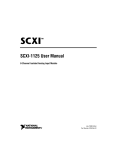

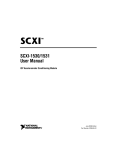

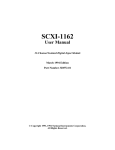
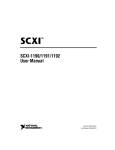
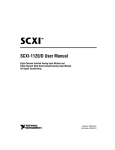
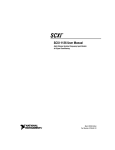
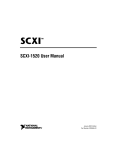
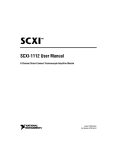
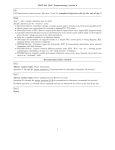
![[Unlocked] SC-2042](http://vs1.manualzilla.com/store/data/005660029_1-1367986a5e7a7fe673239a9957384234-150x150.png)
